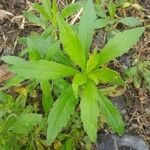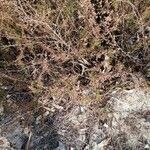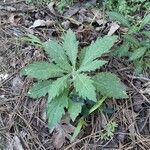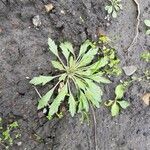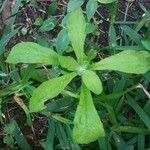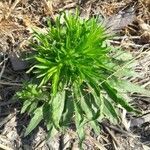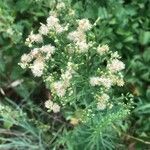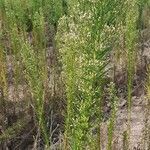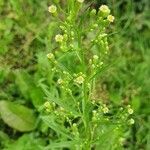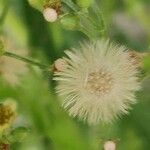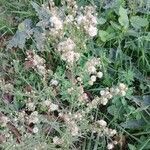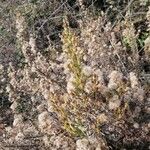Annual herb, up to 1.5 m high; erect. Stems with lateral branches never overtopping main axis, the whole forming a pyramidal, compound inflorescence. Leaves alternate; blade linear or very narrowly elliptic, up to 40 x 5 mm, apex acute, base narrowed, petiole-like, margins entire, ciliate, glabrous or sparsely hairy. Heads minutely radiate, ± 5 mm in diameter, grouped in terminal, lax, leafy panicles. Involucral bracts ± 4-seriate, imbricate, linear, margins of middle rows light-coloured and broader than central darker portion. Flowers: ray florets in several rows, tiny, white or mauve-tinged; disc florets with corollas mostly 4-lobed, whitish or pale yellow; Dec.-Feb. Fruit with cypsela narrowly elliptic, compressed, thinly hairy. Pappus of many, uniseriate, whitish or straw-coloured, barbellate bristles.
A glabrous or sparsely hairy erect herb up to 1.5 m tall, stems very leafy, usually simple below, branching above into an elongated thyrsoid panicle. Leaves linear or narrowly lanceolate, usually up to c. 4 x 0.5 cm, narrowed to a petiole-like base, often with a falcate twist clearly seen in living plants, margins entire or toothed, commonly ciliate. Heads usually about 5 mm across when pressed, with tiny white or mauve-tinged rays easily seen in living material. Involucral bracts in c. 4 series, linear-lanceolate, midline with immersed oil sacs, glabrous or sparsely hairy. Achenes c. 1.5 mm, narrowly elliptic, compressed, thinly hairy, margins thickened. Pappus of whitish scabridulous bristles.
Glabrous or sparsely hairy, annual herb, up to 1.5 m high; lateral branches never overtopping main axis, the whole forming a pyramidal compound inflorescence. Leaves alternate, linear or narrowly lanceolate, margins entire or denticulate, ciliate. Capitula minutely radiate, ± 5 mm in diam. Ray florets white or mauve-tinged, multiseriate. Disc florets tubular. Flowering time Dec.-Apr. Pappus of scabrous bristles, straw-coloured. Cypselae narrowly elliptic, compressed, thinly hairy.
An annual herb. It grows to 1 m tall and spreads to 50 cm across. The stem is erect, hairy and unbranched. The leaves are one after another along the stem and are entire. The lower leaves have leaf stalks and may have teeth around the edge. The leaves are thin and narrow. They are 5 cm long. The flowers are green or pale purple. They occur in clusters at the end of the plant. The bracts around the flower heads are free of hairs. The fruit are downy.
Herb, up to 1.5 m high. Leaves linear or narrowly lanceolate, margins entire or toothed, ciliate. Lateral branches never overtopping main axis, the whole forming a pyramidal compound inflorescence. Heads ± 5 mm in diameter. Pappus straw-coloured. Flowers with white or mauve-tinged rays.
Leaves entire, margins generally long-hirsute; capitula subradiate, corollas of marginal florets subradiate; central colored portion of mid-series phyllaries generally narrower than the light-colored phyllary margin; disk corollas generally 4-lobed.
